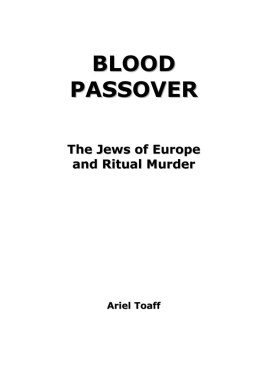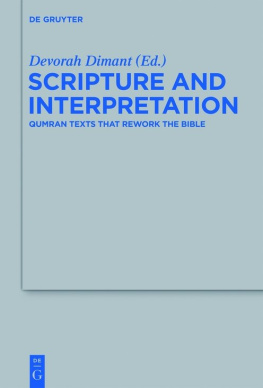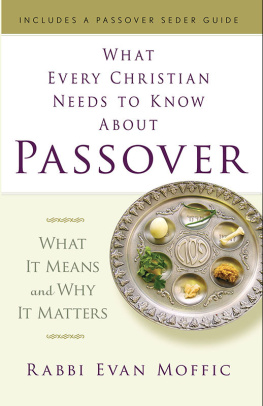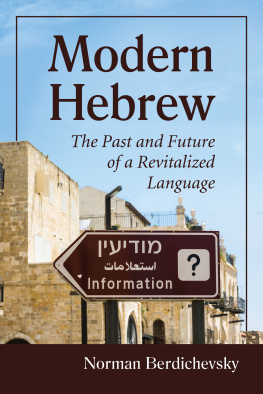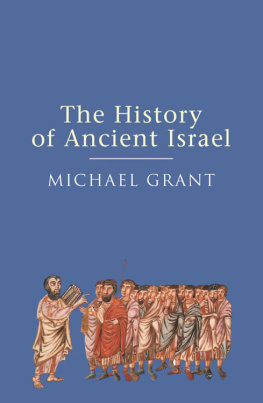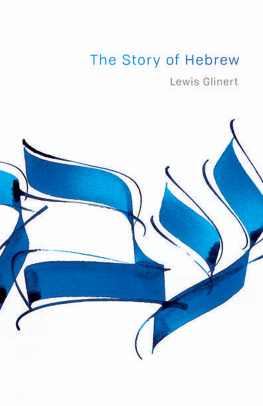Cover: Stone medallion depicting the purported martyrdom of Simonino di Trento, Palazzo Salvatori, Trent.
Inscription on the medallion: In the interior recesses of this building, where a synagogue once stood, but where a shrine has now been built, the blessed martyr Little Simon of Trent was killed with horrible tortures, in the dead of night, by the Jews, at the age of twenty-nine months, on the 10th of April 1475 of our era.
BLOOD PASSOVER
The Jews of Europe and Ritual Murder
by Ariel Toaff
Translated by Gian Marco Lucchese and Pietro Gianetti. Published by Lucchese-Gianetti Editori LLC.
2016 revised edition.
(c) 2007 by Gian Marco Lucchese and Pietro Gianetti. Formal abandonment of copyright: December 24, 2014.
Revised. Please use this version.
Last revision: August 1, 2016.
Annuls and replaces all previous versions.
Table of Contents
FOREWORD BY ORIGINAL TRANSLATORS
The following translation was performed free of charge to protest an injustice: the destruction by the ADL of Ariel Toaff s Blood Passover on Jewish ritual murder. The author is the son of the Chief Rabbi of Rome, and a professor of Jewish Renaissance and Medieval History at Bar-Ilan University in Israel, just outside Tel Aviv.
Dr. Toaff is uniquely qualified to write this book, being thoroughly familiar with the derivative literature in English, French, German and Italian, as well as the original documentary sources in Latin, Medieval Italian, Hebrew and Yiddish. This is not something he worked on in secret. On the contrary, he worked on it openly with his university students and colleagues in Israel for several years; one of his students was even going to publish a paper on the subject. The author is extremely careful about what he says, and his conclusions must be taken seriously. It reads like a detective story.
If it had been published in Israel, in Hebrew, no one would have cared. There are large bodies of literature in Hebrew that Jews do not wish Gentiles to know about. But Dr. Toaff s announcement of its publication in Italy, in Italian, raised a worldwide firestorm of fury. Under unbearable pressure, the book was withdrawn from publication.
Come in out of the darkness, and strike a blow for the light.
READ AND PASS ON.
ON THE NAMES
Candia - Venetian Crete Serenissima - the city of Venice Veneto - region northeast of Venice Mestre - closest mainland city to Venice Podesta - magistrate Ratisbona - Regensburg, Germany
Salamoncino, Simonino, Simoncino - diminutives of Solomon, Simon.
Avogaria di Comun - similar to district prosecutors office We have semi-Italianized the names of certain German Jews living in Italy. Ex.: Samuele da Nuremberg. This is to distinguish them from Germans living in Germany, ex.: Andrea of Rinn.
ON THE TRANSLATION
Prof. Toaff writes with a very large vocabulary, using many words from the Veneziano and Veneto dialects.
His sources include not only the modern derivative literature in English, French, Italian, French and German, but the original documentation in Hebrew, Yiddish, Fatin and medieval Italian, sometimes a thousand years old.
He does not translate or italicize the medieval Fatin or Italian in his footnotes. These are sometimes in a mixture of languages as well.
In most cases, the material contained in the footnotes is simply paraphrased in the text. Where we have attempted to translate this material, it appears in [square brackets]. All translators notes are in [square brackets].
Ex.: Chi cerca dove non deve, trovara qualcosa che non gli piace. [He who looks where he shouldnt, will find something he will not like.] [Sicilian proverb.]
We will continue to translate the Fatin in the footnotes and will issue periodic updates and revisions, all bearing the latest revision date.
Our aim is to produce an absolutely perfect complete translation, including the Fatin where it is of any interest.
This is a long-term project.
The present translation retains the original footnote numeration, but places the footnotes at the end of each chapter, instead of lumping them together at the end of the book.
ON THE TEXT
Prof. Toaff has since partially recanted, and now maintains that:
- yes, Jews are a corrupting and disruptive element in society;
- yes, Jews lend money at 40% and seem to do little else;
- yes, Jews buy and sell justice with huge bribes;
-yes, Jews pull off all sorts of fraudulent bankruptcies and swindles;
- yes, Jews resort to poisoning and assassination when thwarted; -yes, Jews are obsessed with hatred for Christians and the
Christian religion;
- yes, Jews kidnapped and castrated Christian boys on a large scale
and sold them into slavery in Islamic Spain for centuries;
- yes, Jews used [and still use?] human blood in all sorts of quack remedies, despite the Biblical prohibition, even for minor complaints;
-yes, Jews used [and still use?] Christian human blood in their matzoh balls at Passover;
-yes, Jews used [and still use?] Christian human blood in their wine at Passover;
-yes, the blood had to be from Christian boys no more than 7 years of age;
- yes, the blood had [has?] to be certified kosher by a rabbi;
-yes, there was [is?] a large and profitable trade in fake blood
products and animal blood, which was [are?] unsuitable to the purpose;
- yes, Christians tried to sell the blood of Christian boys to Jews, but were rejected because the Jews feared it was animal blood; but no, no Christian boys were ever killed to obtain the blood. Never, never! Or hardly ever. It all came from voluntary donors!
Anybody having read the book will simply laugh.
The only saving clause is that these charges are made against Ashkenazi Jews only. It would be interesting to see how much filthy Sephardic linen the Ashkenazi could air in public if they so chose.
ON THE TITLE
It makes little practical difference, but we feel that the title Blood Passover is preferable to Bloody Passover, for several reasons.
The title is, after all, Pasque di Sangue, not Pasque Sanguinose.
A recipiente di sangue would be a blood receptacle, something intrinsically intended to receive and hold blood, a recipient inextricably bound up with blood by its very nature, by design, as its essence (like those tubes they use when you have a blood test). There is a clear identification between the two nouns, A=B.
A recipiente sanguinoso, a bloody receptacle, would be simply a recipient, of any nature whatever, which had merely become soiled or smeared with blood for some reason, the blood being something fortuitous, accidental, and foreign to its essential nature (for example, if someone hit you in the mouth with an ashtray); wash the blood off, and it is no longer a bloody receptacle.
We believe that it was Prof. Toaff s intention to coin a phrase, like blood money. It is obvious that blood money implies far more than
simply bloody money: it is something specific, something very distinct; a very narrow meaning.
ON THE LATIN
It is obvious that this is not correct classical Latin, nor is it standard medieval Latin, as written by someone trained in literature.
This is the ugly jargon of Venetian notaries, cram-packed with Italian and Venetian words and saids, afore-mentioneds, above-mentioneds, afore-saids, and all the rest of it.
In Venetian, ordinary words which appear to be the same as Italian often have radically different meanings. We believe that this may be reflected in some of the Latin given here. This would account for some of the astonishing translation errors into Latin.

